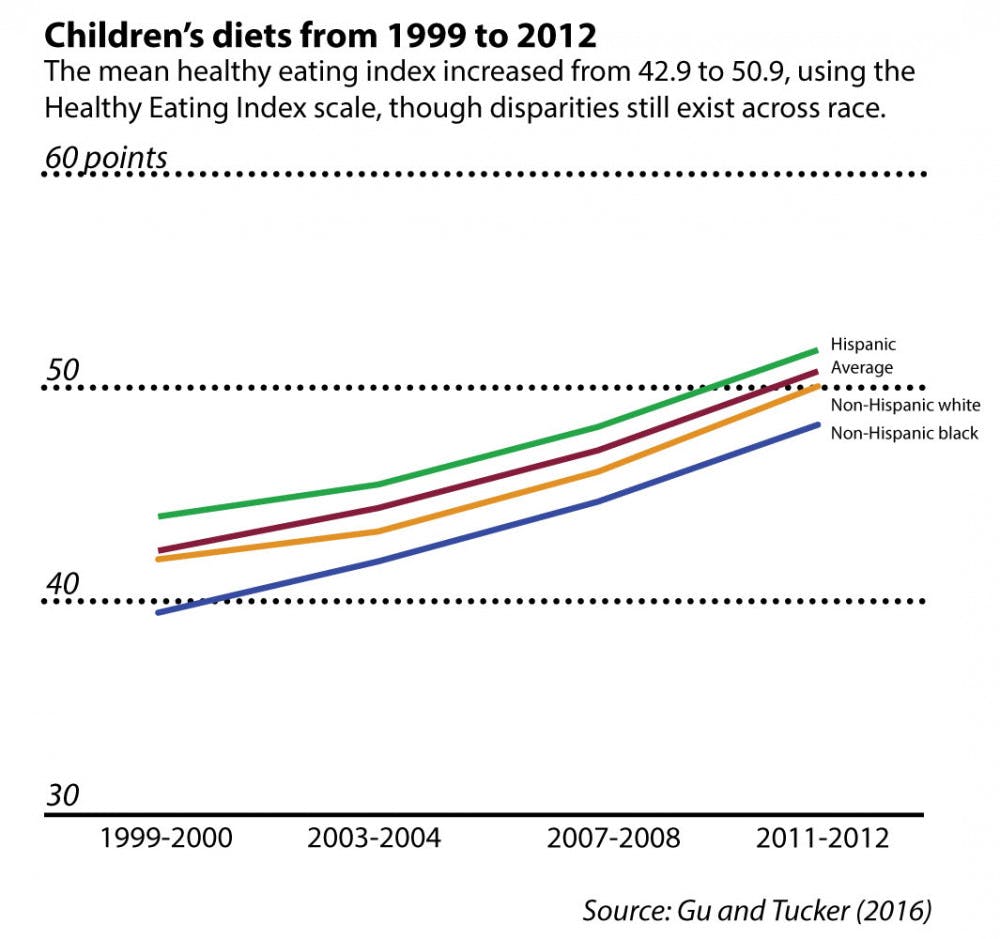Brown researcher Xiao Gu GS conducted an analysis of the diets of children in the United States and found that though childrens’ overall nutrition has markedly improved, it is still far from the ideal. Gu also found that disparities in nutrition exist across race and income.
Published in the American Journal of Clinical Nutrition, the study looks at the diets of 38,487 children from 1999 to 2012 and used the Healthy Eating Index 2010 to gauge progress.
According to corresponding author Katherine Tucker, professor at the University of Massachusetts Lowell, the HEI-2010 is “designed to address the dietary guidelines for Americans” and is a “grade of how you are eating, in relation to how you should be eating.” Each of the 10 contributing component factors are ranked on a scale of zero to 10 and totaled to make up the score, Tucker said.
Using information from the last 14 years, the study found that nutrition has improved but has only reached a high of 50.9 out of 100, a significant increase from 42.5 in 1999. There were multiple factors that contributed to this improvement, including increased intake of whole grains, fruits and vegetables, as well as “decreased consumption of refined grains and empty calories.”
The data is based on the National Health and Nutrition Examination Survey, a survey research program conducted by the National Center for Health Statistics.
Gu said the most significant reason the score improved was a decrease in the consumption of empty calories, which accounted for one-third of the total rise. Despite this reduction in empty calories, sodium intake has increased over the last 14 years, he added.
One important finding is that non-Hispanic black children have a worse dietary quality than non-Hispanic white children, Gu said, adding that this could be due to different diets, like red meats. He is working on a follow-up study on this particular disparity.
For Gu, this research is important because children are in need of special support when it comes to their diets.
“Children are the most vulnerable group in our society. They can’t really decide what to eat. ... (Their) parents should take the responsibility to choose healthy foods for (their) children,” Gu said, adding that nutrition programs are also important.
Patricia Markham Riscia, assistant professor of behavioral and social sciences, said the boost could be attributed to increased awareness among parents as well as paying more attention to nutrition in restaurants and school cafeterias.
“There has been a change in requirements for school lunches,” Riscia said. “There’s been a lot of hard work going on among school systems and cafeterias to provide healthier and tastier healthy foods — so it’s not only healthier, but kids are actually eating it,” she added.
Riscia also pointed toward healthier beverage options and more fruits and vegetables in fast food restaurants as well as a general increase in awareness to establish healthy eating habits.
The study also found that the HEI score of children whose families receive food stamps — or on the Supplemental Nutrition Assistance Program — lagged behind those not on the program, while those on the Women Infants and Children program did better.
Tucker and Gu said that those on SNAP may be more likely to buy cheap, unhealthy foods than those on the WIC program since the WIC program limits food vouchers to healthy options, such as grains, fruits and dairy products.
This disparity should not be attributed to the food stamp programs themselves, Riscia said. Rather, it’s a testament to the fact that those who are low-income may be more exposed to marketing for unhealthy foods and lack an education on healthy foods, she added.
For Tucker and Gu, understanding and studying the health of children is vitally important to maintaining childrens’ health in later life.
“What we know and what we’re learning is that diet is so centrally related to our lifelong health, including later risk of chronic disease, osteoporosis, heart disease (and) even cancer,” Tucker said. “If we don’t get children eating well and maintaining healthy body weight, that translates into adulthood and has long-term life consequences.”





